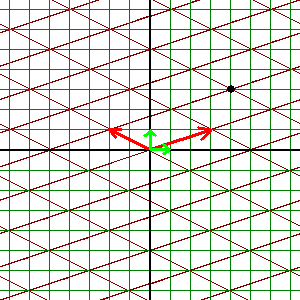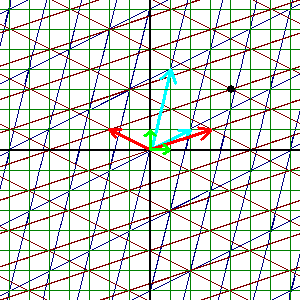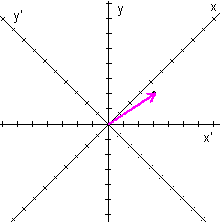|
Change of Basis
Let V be a vector space and let S = {v1,v2, …, vn}
be a set of vectors in V. Recall that S forms a basis for
V if the following two conditions hold:
- S is linearly independent.
- S spans V.
If S = {v1,v2, …, vn} is a basis for V, then every
vector v ∈ V can be expressed uniquely as a linear
combination of v1,v2, …, vn:
|
v = c1v1 + c2v2 + …+ cnvn. |
|
|
Think of |
/
|
|
|
|
|
\ |
|
\
|
|
|
|
|
/ |
as the coordinates of v relative to
the basis S. If V has dimension n, then every set of n
linearly independent vectors in V forms a basis for V. In every
application, we have a choice as to what basis we use. In this
tutorial, we will describe the transformation of coordinates of vectors
under a change of basis.
We will focus on vectors in R2, although all of this generalizes to
Rn. The standard basis in R2 is {[1 0]T,[0 1]T}. We specify other bases
with reference to this rectangular coordinate system.
Let B = {u,w} and B ′ = {u ′,w ′} be two bases for
R2. For a vector v ∈ V, given its coordinates [v]B in basis B we would like to be able to express v in
terms of its coordinates [v]B ′ in basis B ′, and vice versa.
Suppose the basis vectors u ′ and w ′ fo B ′ have the
following coordinates relative to the basis B:
The change of coordinates matrix from B ′ to B
|
governs the change of coordinates of v ∈ V under the change
of basis from B ′ to B:
|
[v]B = P[v]B ′ = |
/
|
\ |
|
|
\
|
/ |
[v]B ′. |
|
That is, if we know the coordinates of v relative to the basis
B ′, multiplying this vector by the change of coordinates matrix
gives us the coordinates of v relative to the basis B.
P viene chiamata anche matrice di transizione dalle nuove coordinate a quelle iniziali.
Why?
The transition matrix P is invertible. In fact, if P is the
change of coordinates matrix from B ′ to B, then P-1 is the
change of coordinates matrix from B to B ′:
Example

Let B = {[1 0]T,[0 1]T} and B ′ = {[3 1]T,[-2 1]T}. The change of basis matrix from B ′ to B is
The vector v with coordinates [v]B ′ = [2 1]T relative to the basis B ′ has coordinates
|
[v]B = |
/
|
\ |
|
|
\
|
/ |
|
/
|
\ |
|
\
|
/ |
= |
/
|
\ |
|
\
|
/ |
|
|
relative to the basis B. Since
we can verify that
|
[v]B ′ = |
/
|
\ |
|
\
|
/ |
|
/
|
\ |
|
\
|
/ |
= |
/
|
\ |
|
\
|
/ |
|
|
which is what we started with.

In the following example, we introduce a third basis to look at the
relationship between two non-standard bases.
Example
|
Let B ′ ′ = |
{ |
|
/
|
\ |
|
2
1
|
\
|
/ |
, |
/
|
\ |
|
1
4
|
\
|
/ |
} |
. |
|
To find the change of coordinates matrix from the
basis B ′ of the previous example to B ′ ′, we first express the
basis vectors
of B ′ as linear combinations of the basis vectors
of
B ′ ′:
|
| |
|
|
|
|
11
7
|
|
/
|
\ |
|
\
|
/ |
− |
1
7
|
|
/
|
\ |
|
\
|
/ |
|
| |
|
|
-9
7
|
|
/
|
\ |
|
\
|
/ |
+ |
4
7
|
|
/
|
\ |
|
\
|
/ |
|
|
| |
|
| |
|
| |
|
|
|
a |
/
|
\ |
|
\
|
/ |
+ b |
/
|
\ |
|
\
|
/ |
|
|
|
|
| c |
/
|
\ |
|
\
|
/ |
+ d |
/
|
\ |
|
\
|
/ |
|
|
| |
|
and solve the resulting systems for a,b,c, and d.
|
|
|
Thus, the transition matrix from B ′ to B ′ ′ is
|
|
/
|
|
|
|
|
\ |
|
\
|
|
|
|
|
/ |
. |
|
The vector v with coordinates [2 1]T
relative to the basis B ′ has coordinates
|
|
/
|
|
|
|
|
\ |
|
\
|
|
|
|
|
/ |
|
/
|
\ |
|
\
|
/ |
= |
/
|
|
|
|
|
\ |
|
\
|
|
|
|
|
/ |
|
|
relative to the basis B ′ ′. This is, back in the standard basis,
|
[ v ]B = |
13
7
|
|
/
|
\ |
|
\
|
/ |
+ |
2
7
|
|
/
|
\ |
|
\
|
/ |
= |
/
|
\ |
|
\
|
/ |
, |
|
which agrees with the results of the previous example.
Rotation of the Coordinate Axes

Suppose we obtain a new coordinate system from the standard
rectangular coordinate system by rotating the axes counterclockwise by
an angle θ. The new basis B ′ = {u ′, v ′}
of unit vectors along the x ′- and y ′-axes, respectively, has
coordinates
in the original coordinate system. Thus,
| P = |
/
|
\ |
|
\
|
/ |
and P-1 = |
/
|
\ |
|
\
|
/ |
A vector [x y]TB in the
original coordinate system has coordinates [x ′ y ′]TB ′ given by
|
|
/
|
\ |
|
\
|
/ |
B ′
|
= |
/
|
\ |
|
\
|
/ |
|
/
|
\ |
|
\
|
/ |
B
|
|
|
in the rotated coordinate system.
Example

The vector [v]B = [3 2]T in the original
coordinate system has coordinates
|
[v]B ′ = |
/
|
|
|
|
|
\ |
|
\
|
|
|
|
|
/ |
|
/
|
\ |
|
\
|
/ |
= |
/
|
|
|
|
|
\ |
|
\
|
|
|
|
|
/ |
|
|
in the coordinate system formed by rotating the axes by 45°.
Note.
• Nel caso di una semplice rotazione degli assi si può osservare che P-1=Pt, ossia che l'inversa della matrice di transizione si può trovare semplicemente scambiando righe con colonne.
Una matrice A tale che A-1= At (ovvero
A×At=I) si dice ortogonale.
[dato che det(At)=det(A) e det(A-1)=1/det(A), si ha che det(A)=±1]
Si può dimostrare che ogni cambiamento di base in cui la nuova base e1,e2 sia ortonormale
(o cartesiana o euclidea),
ossia formata da vettori tra loro perpendicolari e di modulo 1 (ossia tali che ei·ej = 1 se i=j, ei·ej = 0 altrimenti)
è descritto da una matrice di transizione ortogonale (e viceversa: se la matrice di transizione
è ortogonale, da una base cartesiana si ottiene un'altra base cartesiana).
• Nel caso di R3 la rotazione degli assi è caratterizzata dagli angoli formati da ogni nuovo asse col corrispondente vecchio (vedi Geometria delle trasformazioni
lineari).
Nel caso di R2 P ha come prima colonna cos(θ),sin(θ) che equivale a cos(θ),cos(φ) (le
proiezioni del versore di x' sui vecchi assi) dove θ e φ (= π/2-θ) sono
gli angoli che x' forma con x e con y; e come seconda colonna
-sin(θ),cos(θ) che equivale a cos(ψ),cos(θ), dove
ψ (=π/2+θ) e θ sono gli angoli che y' forma con x e y. P-1 ha come elemento di posto (i,j) cos(x'i, xj),
avendo indicato i due assi con x1,x2.
Lo stesso accade per R3, dove x1,x2,x3 stanno per x,y,z
(P è la matrice A considerata alla fine di Geometria delle trasformazioni
lineari; P-1, per quanto osservato nella prima Nota, è la trasposta di A).
Key Concepts [index]
Let B = {u,v} and B ′ = { u ′, v ′ } be two bases for
R2. If [u]B = [a b]T and [v]B = [c d]T, then
is the change of coordinates matrix from
B ′ to B and P-1 is the change of coordinates matrix from B
to B ′. That is, for any v ∈ V,



